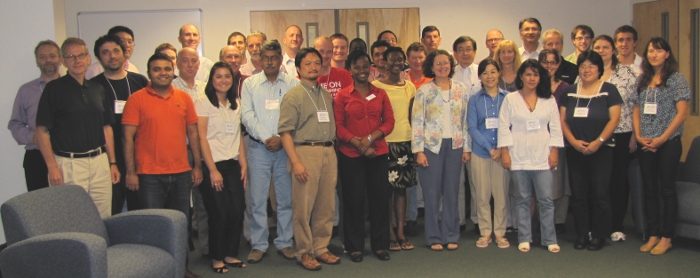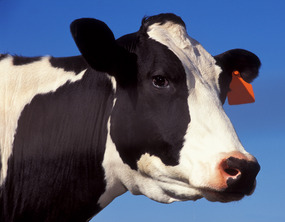| Description | Participants | Agenda | Summary | Talks | Products |
|---|
NIMBioS Investigative Workshop
Modeling Johne's Disease

Topic: Investigating Johne's Disease Epidemiology and Immunology through Mathematical Modeling
Meeting dates: July 6-8, 2011
Location: NIMBioS at the University of Tennessee, Knoxville
Organizers:
Shigetoshi Eda (Center for Wildlife Health, Univ. of Tennessee Knoxville)
Ynte H. Schukken (Dept. Population Medicine and Diagnostic Sciences, Cornell Univ.)
John P. Bannantine (USDA, Agricultural Research Service, Infectious Bacterial Diseases Research Unit)
Ian A. Gardner (Dept. Medicine and Epidemiology, Univ. of California Davis)
Judith Stabel (USDA, Agricultural Research Service, National Animal Disease Center, Ames, IA)
Objectives: Johne's disease (JD) in ruminants is caused by intestinal infection with a bacterial pathogen, Mycobacterium avium subsp. paratuberculosis (MAP). JD causes reduction of milk production, weight loss, and premature culling of clinically affected animals. In the U.S., JD has been found in 68% of dairy herds and causes an estimated annual loss of $220 million to the U.S. dairy industry. Despite long and intensive national-level efforts for JD control, we are still far from preventing the significant economic impact of this formidable disease. One of the major reasons for the continuing struggle with JD is that there are many unknown factors in JD epidemiology and immunology. For example, we do not properly understand the host immune responses to MAP that lead to persistence and sudden exacerbation of the infection. Another major gap in our knowledge is in understanding the prevalence and importance of latent MAP infections. Since the early 1990s, mathematical modeling approaches have been applied for better understanding of JD epidemiology and for estimation of the cost-benefit of alternative JD control strategies. However, there has not previously been an opportunity to gather a multidisciplinary group of scientists to help facilitate mathematical modeling studies in JD. Further, there has been no mathematical modeling approach for studying the immunology (especially host-pathogen interactions) of JD. This workshop will invite scientists in mathematics, biostatistics, epidemiology, veterinary medicine, immunology, molecular biology, and genetics, to facilitate multi-disciplinary collaborations for better understanding of the epidemiology and immunology of JD.
Central theme: The long-term goal of this workshop is to contribute to the control and ultimate eradication of Mycobacterium avium subsp. paratuberculosis (MAP), the cause of Johne's disease (JD), in dairy herds through application of mathematical modeling approaches for better understanding of JD epidemiology, pathogenesis and immune responses. Specific aims of this workshop are:
- To provide an opportunity to gather diverse groups of scientists for facilitation of interdisciplinary discussions on the mathematical modeling of MAP epidemiology, including the role of latent infections in MAP transmission and management issues,
- To establish an initiative in employing mathematical modeling approaches for studying the immune responses and host-pathogen interactions of MAP infections, and
- To investigate methods for linking the epidemiology and immunology models.
Click here for additional information.

Summary Report. During the first two days of the three-day workshop, 11 presentations were made on epidemiology and immunology and their mathematical models. Breakout sessions to discuss challenges, opportunities, and future directions for each objective of the workshop followed the presentations. On the last day, two scientific presentations were made, concluding remarks presented for each objective, and a final group discussion was held. In addition, NIMBioS leadership team members and leaders from the Johne's Disease Integrated Program described possible synergies between the two. During the workshop, new mathematical models were proposed, new research opportunities emerged, and future activities/goals were identified. A proposal for a NIMBioS Working Group will be made to continue this initiative.
Workshop Products
Publications
Martcheva M, Lenhart S, Eda S, Klinkenberg D, Momotani E, Stabel J. Accepted (2015). An immuno-epidemiological model for Johne's Disease in cattle. Veterinary Research Journal.
Robins J, Bogen S, Francis A, Westhoek A, Kanarek A, Lenhart S, Eda S. Accepted (2015). Agent-based model for Johne's disease dynamics in a dairy herd. Veterinary Research Journal.
Lu Z, Schukken YH, Smith RL, Grohn YT. 2013. Using vaccination to prevent the invasion of Mycobacterium avium subsp. paratuberculosis in dairy herds: A stochastic simulation study. Preventative Veterinary Medicine, 110(3-4): 335-345. [Online]
Lu Z, Schukken YH, Smith RL, Mitchell RM, Grohn YT. 2013. Impact of imperfect Mycobacterium avium subsp paratuberculosis vaccines in dairy herds: A mathematical modeling approach. Preventative Veterinary Medicine, 108(2-3): 148-158. [Online]
Magombedze G, Ngonghala CN, Lanzas C. 2013. Evaluation of the "Iceberg Phenomenon" in Johne's Disease through mathematical modelling. PLoS ONE, 8(10): e76636. [Online]
Massaro T, Lenhart S, Spence M, Drakes C, Yang G, Agusto F, Johnson R, Whitlock B, Wadhwa A, Eda S. 2013. Modeling for cost analysis of Johne's disease control based on EVELISA testing. Journal of Biological Systems, 21(4): 1340010. [Online]
Martcheva M. 2011. An immuno-epidemiological model of paratuberculosis. AIP Conference Proceedings, 1404(1): 176-183.
Presentations
Lenhart S. 2 March 2015. Modeling Johne's Disease in dairy cattle. Colloquium Talk, Univ. of California, Irvine, CA.
Lenhart S. 13 February 2015. Modeling Johne's Disease in dairy cattle. Colloquium Talk, Univ. of Texas, El Paso, TX.
Lenhart S. 27 February 2015. Modeling Johne's Disease in dairy cattle. Colloquium Talk, Arizona State Univ.
Lenhart S. 20 December 2014. Modeling Johne's Disease in dairy cattle. Plenary Talk, Workshop on Mathematical Biology and Nonlinear Analysis, Univ. of Miami.
Lenhart S. 26 November 2014. Modeling Johne's Disease in dairy cattle. Plenary Talk, Southern Africa Mathematical Sciences Association Meeting, Victoria Falls, Zimbabwe.
Lenhart S. 24 October 2014. Modeling Johne's Disease in dairy cattle. Plenary Talk, Mississippi State Conference on Differential Equations and Computational Simulations, Mississippi State Univ.
Eda S. May 2013. Mathematical modeling of Johne's disease epidemiology and immunology. Invited Seminar, Universidad Autonoma de Baja California, Mexicali, Mexico.
Magombedze G. February 2013. How to develop immunological models for infectious diseases. Guest Lecture, Howard University, DC.
Magombedze G. February 2013. Transmission and persistence of Johne's Disease. Mathematics Colloquia & Seminar, Howard University, DC.
Eda S, Lenhart S, Stabel J, Bannanitine J, Gardner I, Schukken Y. 5-10 February 2012. Investigative workshop for mathematical modeling of Johne's disease epidemiology. 11th International Colloquium on Paratuberculosis, Sydney, Australia.
Magombedze G. December 2012. Mycobacterium tuberculosis latency regulation: Insights from mathematical and computational modeling. John Hopkins University, Baltimore, MD.
Magombedze G. October 2012. Mycobacterium tuberculosis regulatory mechanisms in latency infection. University of Minnesota, Minneapolis, MN.
Magombedze G. September 2012. Understanding Mycobacterium tuberculosis latency infection. Emory University, Atlanta, GA.
Magombedze G. September 2012. Understanding the underlying mechanisms of persistence in mycobacterial infections. NIMBioS Seminar Series, NIMBioS, University of Tennessee, Knoxville, TN. [Online]
Magombedze G. 27-30 August 2012. Poster: Transmission and persistence of Johne's disease: Is the iceberg phenomenon consistent with disease transmission dynamics. Workshop for Young Researchers in Mathematical Biology, Mathematical Biosciences Institute (MBI), The Ohio State University, Columbus, OH.
Magombedze G. 25-28 July 2012. Assessment of Th1/Th2 immune response paradigm in Mycobacterium avium subspecies paratuberculosis infections. Society of Mathematical Biology (SMB) 2012 Annual Meeting, Knoxville, TN.
Magombedze G. February 2012. FME (R package) for sensitivity analysis in ODES. Math Biology Seminar, University of Tennessee, Knoxville, TN.
Massaro T, Lenhart S, Eda S. 25-28 July 2012. Mathematical modeling for cost analysis of EVELISA-based Johne's disease control. Society of Mathematical Biology (SMB) 2012 Annual Meeting, Knoxville, TN. [Online]
NIMBioS Investigative Workshops focus on broad topics or a set of related topics, summarizing/synthesizing the state of the art and identifying future directions. Workshops have up to 35 participants. Organizers and key invited researchers make up half the participants; the remaining participants are filled through open application from the scientific community. Open applicants selected to attend are notified by NIMBioS within two weeks of the application deadline. Investigative Workshops have the potential for leading to one or more future Working Groups. Individuals with a strong interest in the topic, including post-docs and graduate students, are encouraged to apply. If needed, NIMBioS can provide support (travel, meals, lodging) for Workshop attendees, whether from a non-profit or for-profit organization.
A goal of NIMBioS is to enhance the cadre of researchers capable of interdisciplinary efforts across mathematics and biology. As part of this goal, NIMBioS is committed to promoting diversity in all its activities. Diversity is considered in all its aspects, social and scientific, including gender, ethnicity, scientific field, career stage, geography and type of home institution. Questions regarding diversity issues should be directed to diversity@nimbios.org. You can read more about our Diversity Plan on our NIMBioS Policies web page. The NIMBioS building is fully handicapped accessible.
NIMBioS
1122 Volunteer Blvd., Suite 106
University of Tennessee
Knoxville,
TN 37996-3410
PH: (865) 974-9334
FAX: (865) 974-9461
Contact NIMBioS


